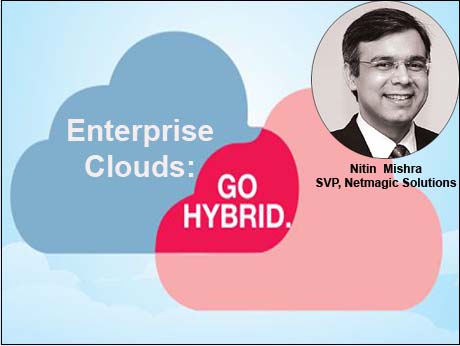
May 30 2015: Nitin Mishra Senior Vice President - Products & Services, Netmagic Solutions, suggests why hybrid is the best cloud option for corporates
It’s true. The cloud is changing the face of enterprise computing. In a recent roundup of market trends and expert predictions, Forbes magazine collated data that demonstrates how widespread the phenomenon has become. Consider the facts:
A Goldman Sachs study published in January 2015 projects that spending on cloud computing infrastructure and platforms will grow at a 30% CAGR from 2013 through 2018 compared to 5% growth for overall enterprise IT.
IDC predicts that by 2016, there will be an 11% shift of IT budgets away from traditional in-house IT delivery, toward various versions of cloud computing as a new delivery model.By 2018, more than 60% of enterprises will have at least half of their infrastructure on cloud-based platforms.
It is clear that Cloud is the way to go. The experts have said it and now the markets are validating it.
The problem is, there are at least three major flavors of cloud computing -- public cloud, private cloud, and hybrid cloud. Which one is right for your organization?
In a public cloud, the IT infrastructure -- hardware, networking, storage, services, applications, and interfaces -- is owned and operated by a third party service providers such as Amazon, CSC, Microsoft, Rackspace, Google, etc. These service providers create a highly scalable data center that hides the details of the underlying infrastructure from the consumer.
In a private cloud, the IT infrastructure is owned and operated by an organization for the use of its employees, partners, and customers. A private cloud can be created and managed by third party providers such as IBM, Cisco, Citrix, Microsoft and others, for the exclusive use of one enterprise.
A hybrid cloud is a private cloud combined with the use of public cloud services. One or several touch points exist between the two environments to combine services and data to create a unified, automated, and well-managed computing environment.
Enterprise IT decision makers, not surprisingly, have been wary of moving their workloads to public clouds because of data security and privacy concerns. For this class of IT users, a hybrid cloud offers a compelling proposition. It’s easy to see why.
In a hybrid cloud, the public and private cloud infrastructures operate independently of each other and communicate over an encrypted connection. This allows organizations to store protected or privileged data on the private cloud, while retaining the ability to leverage computational resources from the public cloud to run applications that rely on this data. This keeps data exposure to a bare minimum because they're not storing sensitive data long-term on the public cloud component.
There are three clear advantages of opting for a hybrid cloud.
Hybrid cloud adoption can be an effective strategy for a wide variety of businesses that have a tight focus on security or have unique physical presence demands. Assembling a private cloud to handle a standard workload, with burst compute offloaded to the public cloud, can be a long-term budget-friendly arrangement.
Ultimately, a hybrid cloud allows organizations to leverage the capabilities of public cloud platform providers without offloading their entire data to a third-party data center. This provides a great deal of flexibility in computing tasks, while keeping the most vital components within the company firewall.
Companies across the world clearly like the idea of the hybrid cloud model. IT research firm Gartner predicts that almost half of large enterprises globally will have deployed a hybrid cloud by the end of 2017, with 2016 being a “defining” year where they will start to move away from private into hybrid.
---------------------------------------------------------------------------------------------------------------------------------------------------------------------------------------------------
Typical use cases for hybrid clouds
IT Sandboxes. Developers can develop, test, and scale new applications in public clouds without compromising a production environment and deploy the final solution in the on-premise private cloud.
Cloud Bursting. Companies can send the overflow traffic into a public cloud during spikes or failovers and only pay for the extra resources when needed.
Big Data Handling. Big data -- everything from social media, clickstream, searches, and more -- is useful to mine but compute intensive to deploy. Companies can run large scale analytics applications in a public cloud and pull in the results on-premise for further analysis or deployment.
Data Storage. Both archival data and dormant data (data not used currently but necessary for occasional analysis or for compliance)can be moved to a hybrid cloud to integrate on-premise systems with public cloud storage.
Disaster Recovery. Building an on premise disaster recovery system is prohibitively expensive. DRaaS (disaster-recover- as-a-service) using a hybrid cloud enables flexible storage, virtual machine replication, and automated failover testing, planned migrations, and recovery.
Enterprise IT/Outsourced Data Centre.Using a hybrid cloud, companies can allocate and balance IT resources between expensive private clouds and cheaper public clouds to manage their exploding data storage requirements.
E-commerce. A hybrid cloud provides a secure, cost-effective, and scalable platform for the deployment of web and e-commerce applications. Additionally, online retailers can leverage their existing IT policies to comply with security and control requirements.